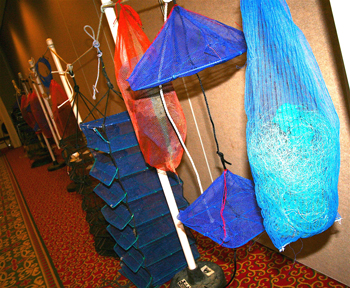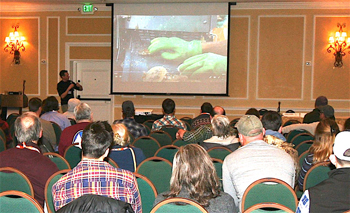Farmed Scallops Are Finding a Market
by Laurie Schreiber

Various types of nets and a technique imported from Japan, called ear-hanging, are used to grow scallops. Laurie Schreiber photo.
The market for farmed scallops is beginning to take off. But marketers are seeing a need to educate chefs and others on how to handle use the product.
Ryan McPherson and Sarah Xiao with Glidden Point Oyster Company in Edgecomb have been taking a lead in opening markets.
“Marketing opens the doors to a lot of different dynamics and questions,” McPherson said during a session scallop farming during the Maine Fishermen’s Forum in early March.
A year ago, Glidden Point formed a relationship with Maine Aquaculture Co-op—a scallop-farming co-op in Tenants Harbor—and has been marketing the product under a spinoff company named Coastal Harvesters. The new company leverages Glidden Point’s customer base along the East Coast and as far as the Midwest, he said.
The new name was needed in order to distinguish the scallop product from Glidden Point’s oyster products, he said.
“The Coastal Harvesters name brings value back to the farmers,” he said.
But the marketing initiative began in 2017, when Glidden Point sold scallops that were 2 ½ inches in size. Glidden Point leveraged messages that include the Maine brand and the diversification of Maine fisheries. Through existing relationships with wholesalers, “things took off pretty quickly,” McPherson said. “The product was unique. Chefs were into it.”
But many chefs didn’t know how to handle or prepare the product, he said.
“We were putting out fires the whole first year,” he said. “It caught us off-guard.”
McPherson told Marsden Brewer, president of the Maine Aquaculture Co-op, that chefs didn’t know how work with the product.
“He connected with his friend and a few weeks later we got out a farm-raised scallop cookbook,” he said. (A free, downloadable PDF by Marnie Reed Crowell is available through the co-op’s website.)
Another challenge, he said, was market competition with wild-caught bay scallops. In 2018, “We had some 3-inch product coming on,” McPherson said. “When we started in November and December, we were in there with the wild bay scallop fishery. That again took me by surprise.”
A year ago, McPherson hired Sarah Xiao to handle marketing.

Hugh Cowperthwaite of Coastal Enterprises Inc. talks about scallop farming at the Maine Fishermen’s Forum. Farmed scallops are generating market buzz. Laurie Schreiber photo.
Xiao started out by implementing a small but successful campaign from March to June at higher-end restaurants in Portland. Asian restaurants in particular, she said, were familiar with the product and required less education.
“We ended the year with a direct-to-consumer push with boutique scallops, which was great because individuals going to retail stores don’t see products like this,” she said.
For 2019, she said, the goal was to avoid competing with the bay scallop fishery and with the beginning of the Maine dayboat wild scallop fishery, so the overall marketing push began this past January.
“After the first sample send-out in early January, people called us,” she said. For example, she heard from a couple of wholesalers, who said their chefs were asking about the product.
“There’s a lot of buzz this year,” she said. “We found that, once the product falls into the right hands, it makes a great impression.”
The product is positioned for the high-end market, she noted.
“After three years of working with the scallops, our product visibility is much better,” she said. “We’re able to pull chefs from across the nation and from Canada. Social media has helped.”
Often, new customers still require a lot of education.
“There’s definitely an educational aspect,” she said. “They also have questions about how it compares with the bay scallop.”
A challenge that remains is getting consistent supply, especially during the time of year when bay scallops are available, she said.
“We need consistent supply with consistent grading,” she said. “But after putting it out there, we know the demand is there. And over the last three years, we’ve created market assets,” including spec sheets, social media campaigns, and visuals.
“The landscape of the market is more competitive and complicated than we anticipated,” she said. “We learned what chefs and wholesalers are comfortable with.”
